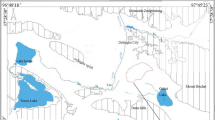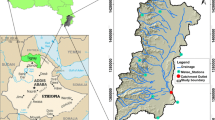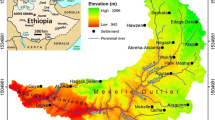Abstract
The Biskra region has recently experienced remarkable economic development due to the extension of agricultural areas. This sustained development has led to increased water demand and exploitation of groundwater, which is the main source for irrigation, industry, and human consumption in the study area. This overexploitation has led to a water deficit throughout the region. Thus, the rational management of water resources has become an indispensable tool to ensure sustainable development. Several techniques and approaches have been developed for spatial groundwater recharge (GR) simulation in arid and semi-arid areas. The WetSpass approach is an exciting modeling technique with a high simulation capacity. After applying the model to the study area, the results show that the monthly average rainfall for the wet and dry periods is 9.6 mm and 8.2 mm, respectively. The rainfall distribution is 4 mm for surface runoff in the wet period and 0.4 mm in the dry period; the real evapotranspiration is 2.4 mm in the wet period and 4.7 mm in the dry period, and the amount of GR is estimated to be 0.4 mm and 0.01 mm in the wet and dry periods, respectively. It can therefore be concluded that WetSpass provides a good basis for simulating the components of the hydrological balance of the study region, and that groundwater recharge is essential for maintaining, utilizing, and preparing water supplies for sustainable management in the study area, particularly in Algeria and in the Mediterranean region in general.






Similar content being viewed by others
References
Abatzoglou JT et al (2018) TerraClimate, a high-resolution global dataset of monthly climate and climatic water balance from 1958–2015. Sci Data 5:1–12. https://doi.org/10.1038/sdata.2017.191
Abdennour MA, Douaoui A, Barrena J et al (2020) Geochemical characterization of the salinity of irrigated soils in arid regions (Biskra, SE Algeria). Acta Geochim. https://doi.org/10.1007/s11631-020-00426-2
Abdi O (2019) Climate-triggered insect defoliators and forest fires using multitemporal landsat and terraclimate data in NE Iran: an application of GEOBIA treenet and panel data analysis. Sensors (Switzerland). https://doi.org/10.3390/s19183965
Al-Kuisi MA, El-Naqa A (2013) GIS based spatial groundwater recharge estimation in the Jafr Basin, Jordan—application of WetSpass models for arid regions. Rev Mex Cienc Geol 30(1):96–109
Amichi F, Bouarfa S, Lejars C, Kuper C, Hartani H, Daoudi A, Amichi H, Belhamra M (2015) Des serres et des hommes: des exploitations motrices de l’expansion territoriale et de l’ascension socioprofessionnelle sur un front pionnier de l’agriculture saharienne en Algérie. Cahiers Agric 24(1):11–19
Armanuos AM, Negm A, Yoshimura C (2016) Application of WetSpass model to estimate groundwater recharge variability in the Nile Delta aquifer. Arab J Geosci. https://doi.org/10.1007/s12517-016-2580-x
Armbruster V, Leibundgut C (2001) Determination of spatially and temporally highly detailed groundwater recharge in porous aquifers by a SVAT model. Phys Chem Earth Part B 26(7–8):607–611
Arnold JG, Muttiah RS, Srinivasan R, Allen PM (2000) Regional estimation of baseflow and groundwater recharge in the upper Mississippi River basin. J Hydrol 227:21–40
Ashaolu ED (2017) Water resources management: a geographer’s viewpoint. In: Tilakasiri SL (ed) Geography in development: issues and perspectives. Stamford Lake, Pannipitiya, pp 151–171
Ashaolu ED (2020) Spatial and temporal recharge estimation of the basement complex in Nigeria, West Africa. J Hydrol Reg Stud 27:100658. https://doi.org/10.1016/j.ejrh.2019.100658
Babama’aji R (2013) Impacts of precipitation, land use land cover and soil type on the water balance of Lake Chad Basin. PhD Thesis. University of Missouri, Kansas City
Batelaan O, De Smedt F (2001) WetSpass: a flexible, GIS-based, distributed recharge methodology for regional groundwater modelling. Impact Hum Act Groundw Dyn 269(269):11–17
Batelaan O, De Smedt F (2004) Seepage, a new modflow drain package. Ground Water 42(4):576–588
Batelaan O, De Smedt F (2007) GIS-based recharge estimation by coupling surface-subsurface water balances. J Hydrol 337:337–355
Batelaan O, Woldeamak ST (2007) ArcView interface for WetSpass: user manual. Version 13-06-2007. Department of Hydrology and Hydraulic Engineering, Vrije Universiteit Brussels, Brussels, p 67
Batelaan O, De Smedt F, Triest L (2013) Regional groundwater discharge: phreatophyte mapping, groundwater modelling and impact analysis of land-use change. J Hydrol 275(1–2):86–108
Bencheikh A (2018) Intensification et mise en valeur pour une agriculture durable dans les régions arides: cas de la wilaya de Biskra. Thèse de Doctorat en Sciences Agronomiques. Ecole Nationale Supérieure Agronomique. Alger, p 129
Boualem R (2007) La problématique de l’eau en Algérie, 2ème édition. Office des Publications Universitaires, Alger, p 114
Boudibi S (2021) Modeling the impact of irrigation water quality on soil salinization in an arid region, case of Biskra. Mohamed Khider University of Biskra, Biskra, p 175
Boudibi S, Sakaa B, Zapata-Sierra AJ (2019) Groundwater quality assessment using GIS, ordinary kriging and WQI in an arid area. Ponte 75:204–226. https://doi.org/10.21506/j.ponte.2019.12.14
Boudibi S, Sakaa B, Benguega Z et al (2021a) Spatial prediction and modeling of soil salinity using simple cokriging, artificial neural networks, and support vector machines in El Outaya plain, Biskra, southeastern Algeria. Acta Geochim. https://doi.org/10.1007/s11631-020-00444-0
Boudibi S, Sakaa B, Benguega Z (2021b) Spatial variability and risk assessment of groundwater pollution in El-Outaya region, Algeria. J Afr Earth Sci 5:1. https://doi.org/10.1016/j.jafrearsci.2021.104135
Boudjellal AA, Bekkar Y, Kuper M, Errahj M, Hammani A, Hartani T (2011) Analyse des arrangements informels pour l’accès à l’eau souterraine sur les périmètres irrigués de la Mitidja (Algérie) et du Tadla (Maroc). Cahiers Agric 20:85–91. https://doi.org/10.1684/agr.2010.0458
Boudjema A (2015) Hydrogéologie, vulnérabilité et modélisation de la nappe du Mio-Pliocène d’El Outaya, (Biskra, Sud-Est algérien). Thèse de Doctorat en Sciences Agronomiques. University Mohamed Khider Biskra, Biskra
César E (2012) Modélisation régionale des écoulements souterrains et du transport de nitrates dans le bassin de la Dyle amont. Thesis. University of Liège, Liège, pp 2011–2012
Chabaca MN (2019) Quelles stratégies d’adaptation pour une meilleure gestion des ressources en eau: cas de l’Algérie (What adaptation strategies for better management of water resources: the case of Alger). In: Séminaire international « Eau et changement climatique au Maghreb. Défis et opportunités», Tunis, Tunisie, 25–26 Nov 2019
Cosgrove WJ, Loucks DP (2015) Water management: current and future challenges and research directions. Water Resour Res 51:4823–4839. https://doi.org/10.1002/2014WR016869
Dams J, Woldeamlak TS, and Batelaan O (2008) Predicting land-use change and its impact on the groundwater system of the Kleine-Nete catchment, Belgium. Hydrol Earth Syst Sci 12:1369–1385. https://doi.org/10.5194/hess-12-1369-2008
FAO (2011) 9. Soil permeability. https://www.fao.org/fishery/docs/CDrom/FAO_Training/FAO_Training/General/x6706e/x6706e09.htm#top
Fenta AA, Kifle A, Gebreyohannes T, Hailu G (2014) Spatial analysis of groundwater potential using remote sensing and GISbased multi-criteria evaluation in Raya Valley, northern Ethiopia. Hydrogeol J 23(1):195–206. https://doi.org/10.1007/s10040-014-1198-x
Gebremeskel G, Kebede A (2017) Spatial estimation of long-term seasonal and annual groundwater resources: application of WetSpass model in the Werii watershed of the Tekeze River Basin, Ethiopia. Phys Geogr. https://doi.org/10.1080/02723646.2017.1302791
Ghiglieri G, Buttau C, Arras C, Funedda A, Soler A, Barbieri M, Carletti A (2021) Using a multi-disciplinary approach to characterize groundwater systems in arid and semi-arid environments: the case of Biskra and Batna regions (NE Algeria). Sci Total Environ. https://doi.org/10.1016/j.scitotenv.2020.143797
Hassan A, Aboodi A, Hassan A (2020) Estimation of spatial groundwater recharge using WetSpass model in Teeb Area, Missan Province, South of Iraq. Technol Rep Kansai Univ 62(7)
JORA (2005) Journal Officiel de la République Algérienne. La loi n°05 – 12 du 04 août 2005 relative à l’eau. http://www.interieur.gov.dz/index.php/fr/le-ministere/le-minist%C3%A8re/textes-legislatifs-et-regl
Kerapetse C, Kileshye OJ, Gumindoga W, Sheffield J (2020) A WetSpass model based groundwater recharge zone mapping for food security in Notwane catchment. In: 19th WaterNet Symp, Livingstone, Zambia, 31 Oct–2 Nov 2018
Khomri Z, Chabaca MN (2019) Contribution to the determination of potential areas for recharge of the El Madher plain water table by a cartographic approach (Batna, Algeria). Ponte Int Sci Res J 75:12. https://doi.org/10.21506/j.ponte.2019.12.7
Manfreda S, Fiorentino M, Iacobellis V (2005) DREAM: a distributed model for runoff, evapotranspiration, and antecedent soil moisture simulation. Adv Geosci 2:31–39
Melki A, Abdollahi K, Fatahi R, Abida H (2017) Groundwater recharge estimation under semi arid climate: Case of Northern Gafsa watershed, Tunisia. J Afr Earth Sci 132:37–46. https://doi.org/10.1016/j.jafrearsci.2017.04.020
Meresa E, Taye G (2019) Estimation of groundwater recharge using GIS-based WetSpass model for Birki watershed, the eastern zone of Tigray Northern Ethiopia. Sustain Water Resour Manag 5(4):1555–1566. https://doi.org/10.1007/s40899-018-0282-0
Mogheir YA (2013) Effects of climate change on groundwater resources (Gaza Strip case study). Int J Sustain Energy Environ 1:136–149
Mustafa ST et al (2017) Identification of the influencing factors on groundwater drought and depletion in north-western Bangladesh. Hydrogeol J. https://doi.org/10.1007/s10040-017-1547-7
Park CS (2014) A distributed water balance approach to groundwater recharge estimation for Jeju Volcanic Island, Korea. Geosci J 18:193–207
Qu X, Alvarez PJJ, Li Q (2013) Applications of nanotechnology in water and wastewater treatment. Water Res 47(12):3931–3946. https://doi.org/10.1016/j.watres.2012.09.058
Safar-Zitoun M (2019) Plan National Sécheresse Algérie. Convention des Nations Unies de Lutte contre la Désertification, Paris
Salami Y (2019) L'Algérie, pays soumis au stress hydrique élevé. Liberte Algérie, 15 Aug 2019. https://www.liberte-algerie.com/actualite/lalgerie-pays-soumis-au-stress-hydrique-eleve-321877.
Sedrati N (2011) Origines et caractéristiques physico-chimiques des eaux de la wilaya de Biskra-Sud-Est-Algérien. Badji Mokhtar-Annaba University, Annaba
Sekkoum K, Talhi MF, Cheriti A, Bourmita Y, Belboukhari N, Boulenouar N, Taleb S (2021) Water in Algerian Sahara: environmental and health impact. In: Ning RN (ed) Advancing desalination. InTechOpen Ltd, London, pp 199–2016. https://doi.org/10.5772/50319.
Shaban A, Khawlie M, Abdallah C (2006) Use of Remote Sensing and GIS to Determine Recharge Potential Zone: The Case of Occidental Lebanon. Hydrogeology J. 14, 433-443. https://doi.org/10.1007/s10040-005-0437-6
Souak F Z (2009) La politique de l’eau en Algérie: valorisation et développement durable. “Bridging divides for water”. In: Cinquième forum mondial de l’eau, Istanbul, Turkey, 16–22 Mar 2009. http://www.enssea.net/enssea/majalat/1003.pdf
Tammal MK (2014) Modeling multi-aquifer system of Tadla basin and plateau of phosphates. Int J Innov Sci Res 6:172–180
Teklebirhan A, Dessie N, Tesfamichael G (2012) Groundwater recharge, evapotranspiration and surface runoff estimation using WetSpass modeling method in Illala catchment, northern Ethiopia. Momona Ethiop J Sci 4(2):96–110
Tesfamichael G et al (2013) Application of a spatially distributed water balance model for assessing surface water and groundwater resources in the Geba basin, Tigray, Ethiopia. J Hydrol 499(2013):110–123
Tilahun K, Merkel BJ (2009) Estimation of groundwater recharge using a GIS-based distributed water balance model in Dire Dawa, Ethiopia. Hydrogeol J 17(6):1443–1457. https://doi.org/10.1007/s10040-009-0455-x
Wang YL et al (2012) Monthly spatial distributed water resources assessment: a case study. Comput Geosci J 45:319–330. https://doi.org/10.1016/j.cageo.2011.11.028
World Bank (2006) Ethiopia : Managing Water Resources to Maximize Sustainable Growth. Washington, DC. © World Bank. https://openknowledge.worldbank.org/handle/10986/8170.
Zammouri M et al (2014) Assessment of the effect of a planned marina on groundwater quality in Enfida plain (Tunisia). Arab J Geosci 7:1187–1203. https://doi.org/10.1007/s12517-012-0814-0
Zomlot Z, Verbeiren B, Huysmans M, Batelaan O (2015) Regional studies spatial distribution of groundwater recharge and base flow. Assessment of controlling factors. J Hydrol 4:349–368
Acknowledgements
The authors would like to thank Prof. Zekai Şen of Medipol University (Turkey) for his insightful comments on the final revisions of the manuscript.
Funding
This research did not receive any specific funding from public, commercial, or nonprofit funding agencies.
Author information
Authors and Affiliations
Contributions
All authors participated in (a) conception and design or the analysis and interpretation of the data; (b) drafting the article or revising it critically for important intellectual content; and (c) approving the final version. This manuscript has not been submitted to, nor is it under review by, another journal or publishing venue. The authors have no affiliation with any organization with a direct or indirect financial interest in the subject matter discussed in the manuscript.
Corresponding author
Ethics declarations
Conflict of interest
The authors declare no conflict of interest.
Additional information
Responsible Editor: Helder I. Chaminé.
Rights and permissions
About this article
Cite this article
Khomri, Ze., Chabaca, M.N., Boudibi, S. et al. Spatial simulation of groundwater recharge in an arid region (Biskra, SE Algeria). Euro-Mediterr J Environ Integr 7, 103–117 (2022). https://doi.org/10.1007/s41207-021-00288-x
Received:
Accepted:
Published:
Issue Date:
DOI: https://doi.org/10.1007/s41207-021-00288-x




